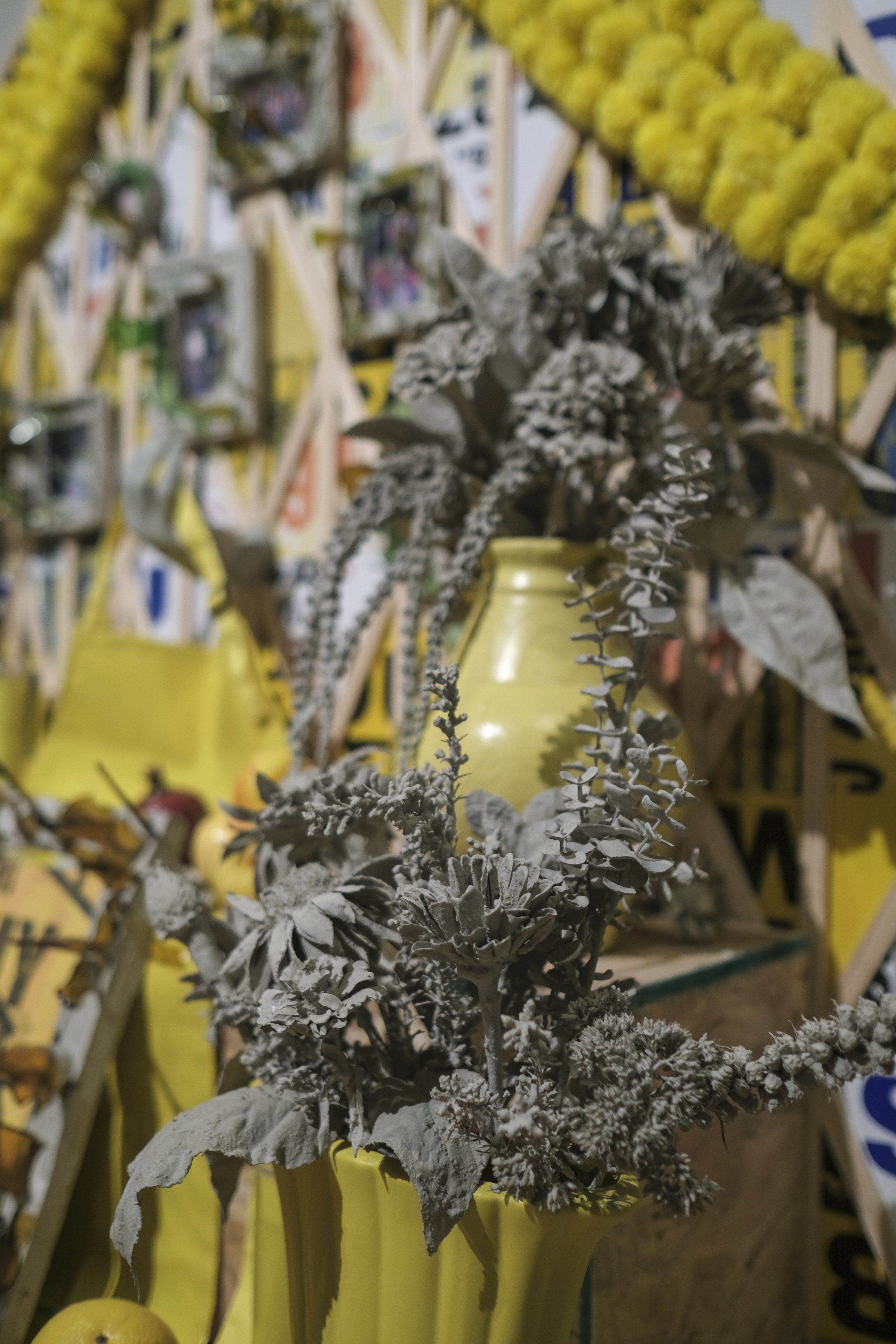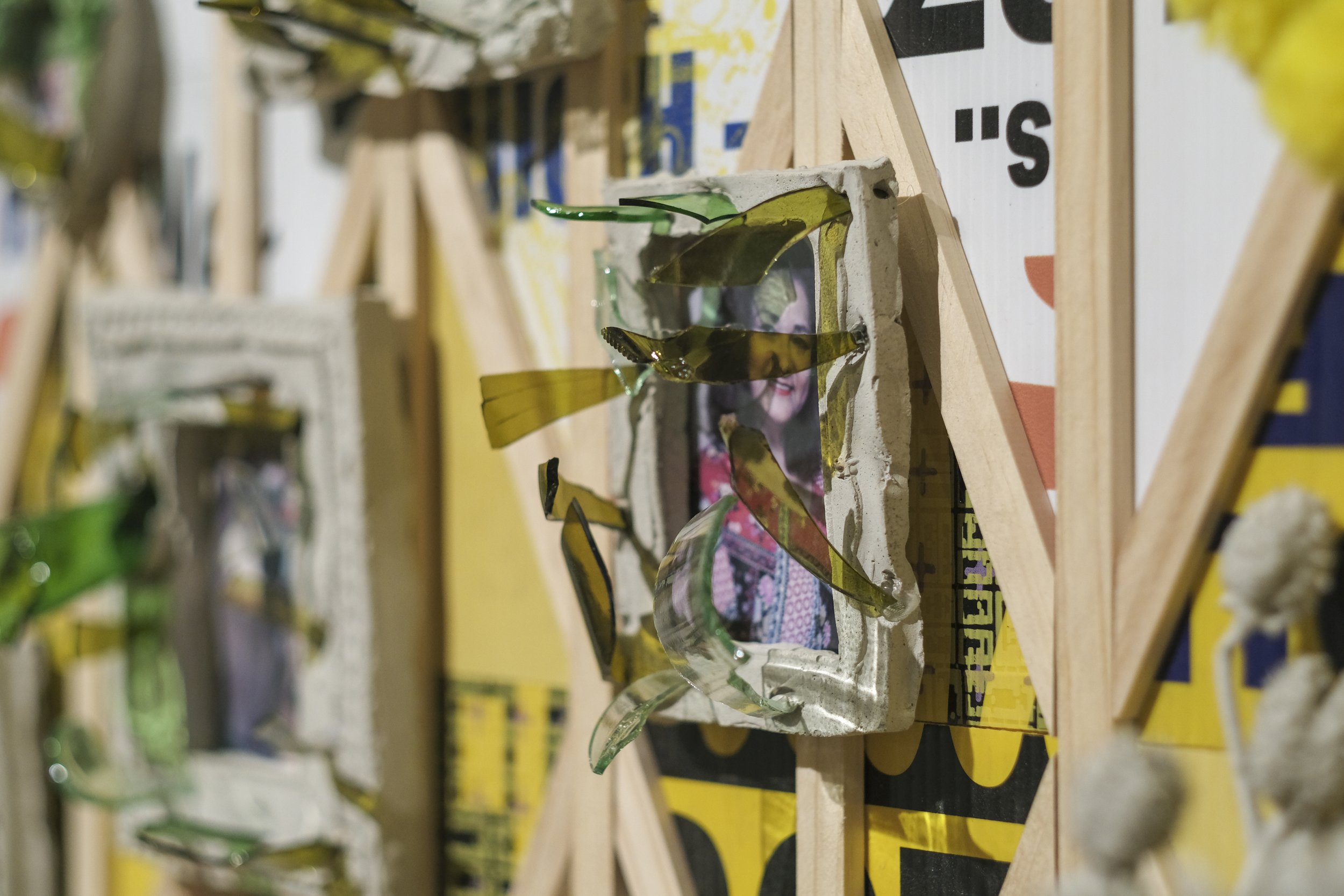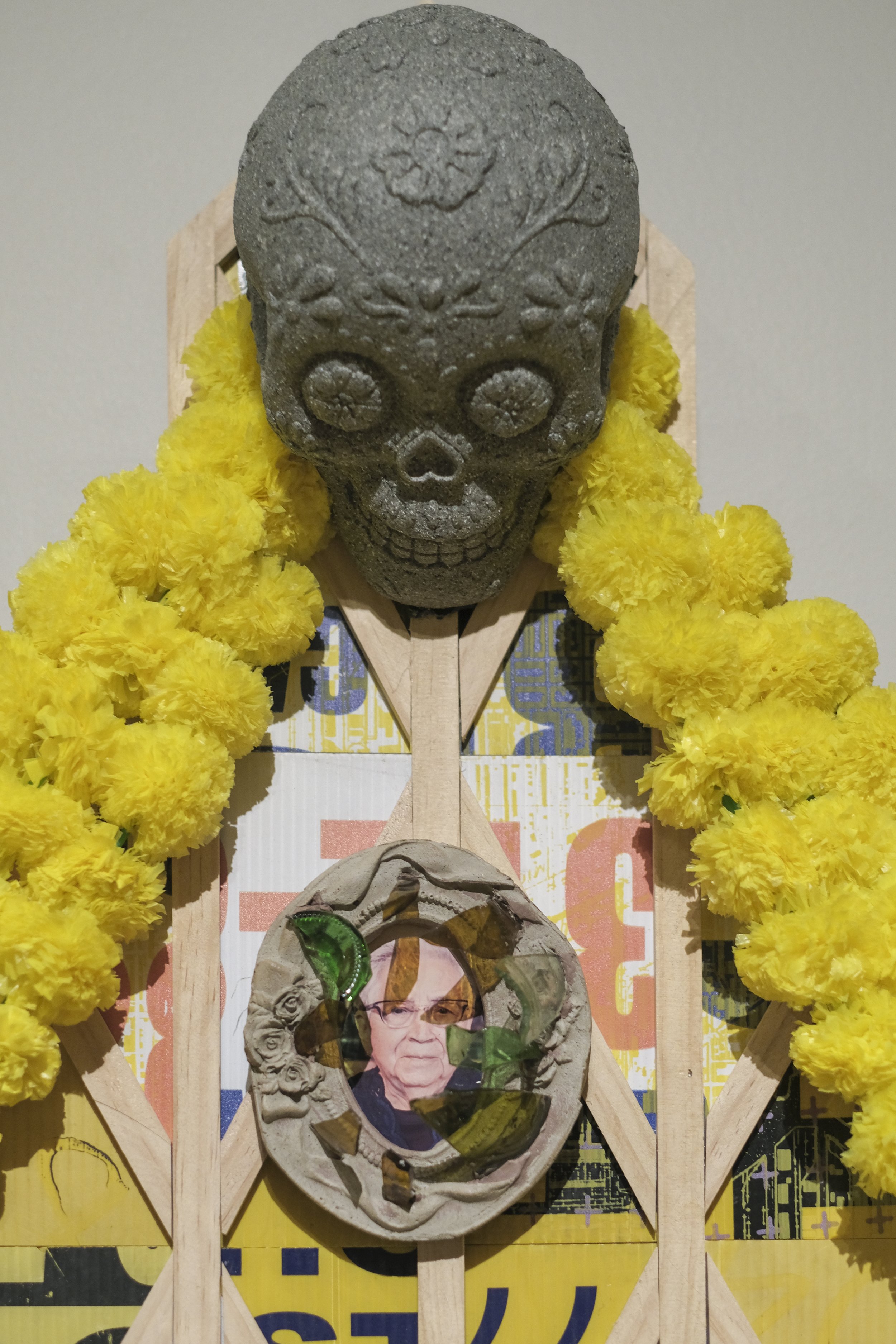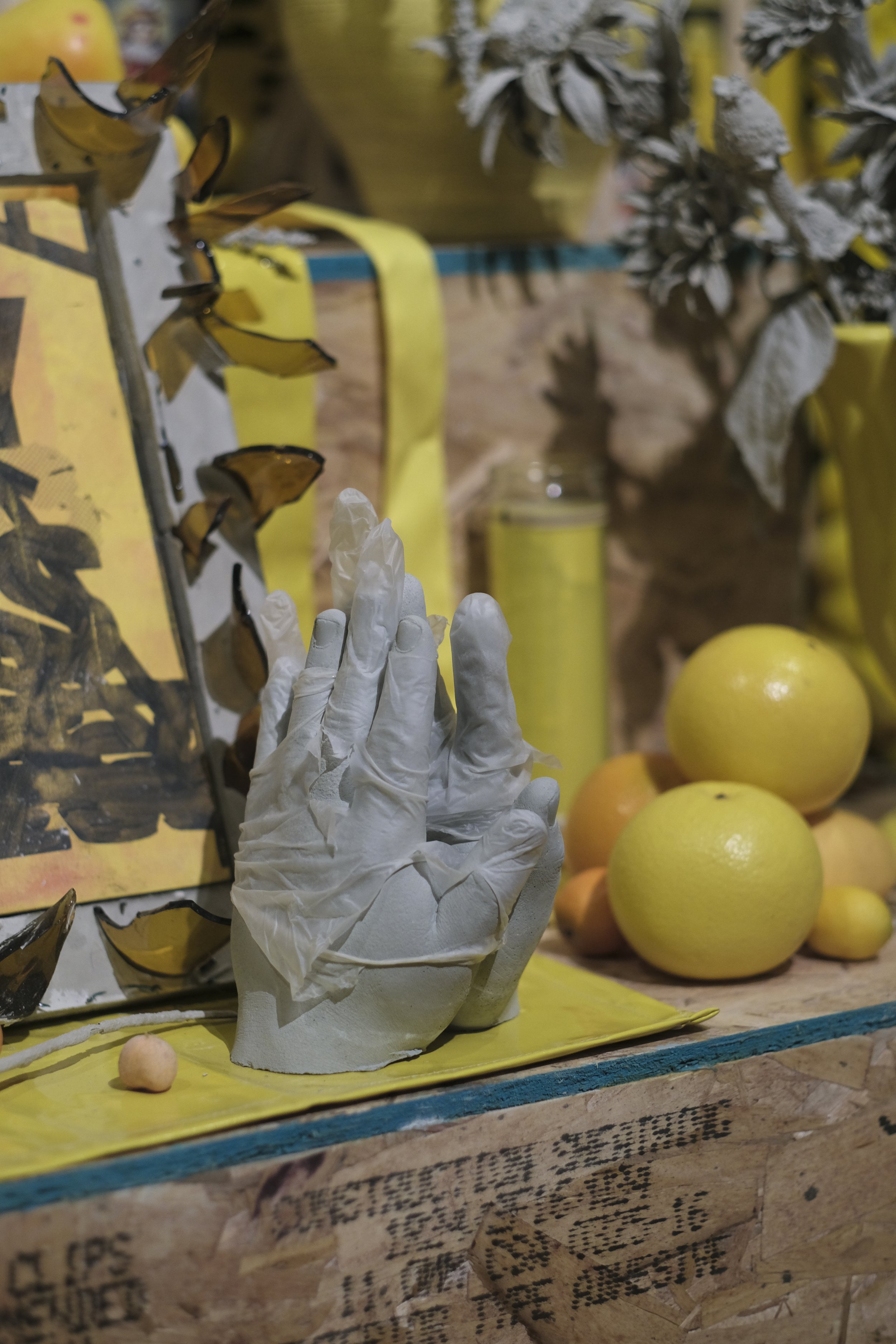Carlos Flores’ Ofrenda a los Arrancados: Ofrenda as Archive
Carlos Flores’ Ofrenda a los Arrancados is an ofrenda dedicated to the working class communities in the Lower West Side and Southwest Side of Chicago, who have been hit hardest by the COVID-19 pandemic and its lasting effects. At first glance, the ofrenda appears raw and undone—some of the more traditional elements clash with some that appear novel or out-of-place. Yet the installation, which is featured in the 2022 Día de Muertos Memories & Offerings exhibition at the National Museum of Mexican Art in Chicago, purposefully embeds construction materials from the urban landscape, such as concrete flowers, ‘bandit signs’, and broken bottles. Flores assembles a culturally-informed alternative to the Western colonial archive, an archive to the departed in which they are reinserted into the setting from which they are being eradicated to highlight the tensions between public health, gentrification, and forced displacement.
The archive, as we most know it, is a curated collection of items and histories that are deemed worthy of preservation. Yet who decides this? Archives, as both institutions and places of social memory, have controlled access and regulations on how to navigate them. As you enter an archive, you are required to leave things just as you found them; which is presumed to be in its original state when it was created. This shapes public perception and memory by prioritizing a hierarchy of certain histories and forms of knowledge. Archives become entrenched within the power structures that create them, and those who find their own histories erased, silenced,¹ or missing, recognize the absences as epistemicides² (epistemological genocide) and historical violence.
This has led many to become the creators and curators of their own autonomous, counter-hegemonic archives. Through acts of recovery, reclamation, and even speculation or critical fabulation,³ these initiatives seek to excavate and create new meanings of the archive and emphasize that it can take many forms. In doing so, we understand that archives are not removed from our lived realities. They are impacted by the hands that sift through them and steward them. Hence, we influence archives just as much as they us.
By creating an ofrenda, Flores is tapping into a millennia-old pre-Columbian tradition of remembering the dead. The ofrenda is a multi-layered structure or designated space that draws from Native cosmogony and Catholic ideology to create a series of offerings for Día de Muertos. The ritual takes place through November 1st and 2nd, marrying All Saint’s Day with Day of the Dead and celebrating life and death to welcome the spirits of those who have passed. Distinct from an altar, it does not seek to worship. Rather, an ofrenda contemplates, remembers, and preserves memory. The ofrenda—an accumulation of histories—employs non-western traditions to embody a different possibility to the archive.
Chicago-based artist and community organizer Carlos Flores (b. 1992, Guadalajara, Mexico) works directly with the issues that afflict his communities. He arrived in the neighborhood of Little Village as a child from Mexico and lived there until last year. Little Village, more commonly known as La Villita, is a densely-populated neighborhood where 80% of its residents are of Mexican descent.⁴ It continues to be an arrival point for many migrants. Located at the axis of Chicago’s industrial corridors,⁵ the site of Cook County jail, its highly-urbanized landscape is also highly policed and surveilled, with few green spaces. In addition, factory smokestacks continue to emit pollutants which have caused residents to experience some of the highest rates of asthma, as well as some of the highest lead levels in infants’ blood.⁶ Due to the city’s inaction and despite grassroots community organizing, many residents experience this as yet another example of environmental racism.
The residents of La Villita, along with those of Pilsen—another neighborhood of Mexican and Latinx/e migrants directly to its East—have also been forced (and priced) out of their homes. In Pilsen, gentrification can arguably be traced to the late 1970s and early 1980s when the Podmajersky family began purchasing empty warehouses and homes to fabricate housing that attracted young, white artists. This practice was branded as revitalizing a “dying neighborhood.”⁷ This was also an attempt to aestheticize the looks of gentrification, which was pleasing to the city in contrast to the aesthetics of an ethnic enclave. Despite high unemployment rates and pressure to sustain themselves, Pilsen was already a community of Mexican families and artists. This rhetoric used by Podmajersky and subsequent developers suggests the disposability and invisibility of the people who already live in the neighborhood.
To examine the gentrification of today, Flores undertakes the weaponization of ‘bandit signs,’ which are brightly colored corrugated plastic signs that have allowed real estate developers to “hide behind a phone number.”⁸ He has collected thousands of these posters. Entirely harmful to the environment, they often read “WE BUY HOMES QUICK” and “QUICK CASH FOR HOMES,” and are aimed at attracting current residents into rapid, seemingly uncomplicated sales for homes that will be destroyed in preparation for newer, more expensive housing structures designed with upper-middle classes in mind. The backing to the ofrenda’s structure is made of these bandit signs and raw particle board. These elements also add to the yellow monochromatic palette. For Flores, the yellow is synonymous with these predatory ventures, but he aims to subvert its use in exchange for placemaking. In repurposing these bandit signs, Flores situates the urban landscape in the contemplative space of the museum to interrogate notions of belonging amongst the fleeting migrant, working-class, and Latinx/e populations in these neighborhoods of Chicago.
In Ofrenda a los Arrancados, Flores honors specific community members from La Villita and Pilsen who have died during the pandemic, such as Pedro Medina, a member of Mariachi Angeles de Puebla who would often play at Mi Tierra Restaurant in Little Village, and Olga Quiroga, a Chicago Public School Teacher who was among the first Chicago teachers to die of COVID.⁹ Each of their photographs hang at the top of the ofrenda in personalized frames of cement and glass. These frames mirror the type of fashioned-security gate one would see in Mexico as a means to protect a home. For Flores, it refers to methods of autoconstrucción, an improvised building technique that uses layers of cement and glass as separators. This material selection further solidifies how the migrant and working class populations have made homes out of La Villita and Pilsen. They are, however, being pushed out, which becomes most evident when examining the architecture. La Villita is home to a large commercial center, mostly concentrated along 26th street, which has often been compared to downtown Chicago's Magnificent Mile. While previously this avenue has been full of locally-owned businesses, they are now being replaced with national chains, an indication of the changing face of the neighborhood.




Although Flores’ ofrenda memorializes certain community members by including their photographs, it is also an ode to the essential workers who were subject to in-person work during the pandemic while many others were afforded the privileges of working remotely. This is evident through the concrete hands that hold a yellow apron, and the set of praying hands on the lower level of the ofrenda. By centering this working population, Flores also emphasizes how these people had to prioritize their work over their health—a critique of the capitalist urgency to return to ‘normalcy’. This vicious cycle experienced by the working and lower classes is now being exacerbated by increased living costs and forced displacement. If we consider the title of his ofrenda, “a los Arrancados,” the English translation of ‘uprooted’ does not fully encapsulate the force and physicality involved with such an action.
Some of the offerings that Flores includes are interwoven with some of his personal history as it relates to other La Villita and Pilsen residents. He includes citrus fruits that remind him of his childhood in Mexico, sugar skulls, and cempasúchil (marigold) flowers often found on ofrendas. Additionally, he places cement casted flowers and weeds; these flowers, native to Mexico and Central America, were grown on Flores’ microfarm at his home, and the weeds were pulled from La Villita and Pilsen, a representation of some of the attempts to preserve and increase green spaces in these areas. By casting these natural elements in cement, he sets them in time and constructs a different form of the archive that lives through an ofrenda installation. Flores is invested in providing visibility to these communities already experiencing health disparities, and in this latest phase of gentrification, a removal from their environment. His installation, Ofrenda a los Arrancados, reveals to viewers the potential of the archive, much like the ofrenda, to be a process—one that will have many authors in its future and that will witness many changes. One can hope that as it grows each year, it is up to us to look after the histories that are at risk of being erased or forgotten.
—
Notes
¹ Michel-Rolph Truillot, Silencing the Past: Power and Production of History (Boston): Beacon Press, 1995.
² Boaventura de Sousa Santo, Epistemologies of the South: Justice Against Epistemicide (London and New York): Routledge, 2014.
³ Saidiya Hartman, "Venus in Two Acts," Small Axe 12, no. 2 (2008): 1-14. muse.jhu.edu/article/241115.
⁴ Justin Horowitz, “Coffee & Incubation: How Chicago’s Little Village plans to fight youth displacement and gentrification, Medill Reports, Jan. 21 2000, https://news.medill.northwestern.edu/chicago/coffee-incubation-how-chicagos-little-village-plans-to-fight-youth-dis-placement-and-gentrification/.
⁵ To see more about Environmental Justice in Little Village: http://www.lvejo.org/our-community/map/ej-and-little-village-industrial-corridor-map/.
⁶ Kyra Lyons, “A Chicago neighborhood Is Redefining Toxicity in Pursuit of Environmental Justice,” yes!, Feb 23 2022, https://www.yesmagazine.org/environment/2022/02/23/chicago-environmental-justice-pollution.
⁷ Pilsen: Port of Entry, WTTW Chicago (1980), https://www.youtube.com/watch?v=UZRjOhgaEUs.
⁸ Interview with the artist.
⁹ Jason Beeferman, “CPS teacher Olga Quiroga died of COVID-19 gets honorary street outside school: ‘Her students were her kids,’” Chicago Sun Times, Oct. 28, 2021, https://chicago.suntimes.com/news/2021/10/28/22751314/students-teachers-honor-cps-teacher-died-covid-coronaviruser-olga-quiroga.
Marina M. Álvarez (she/her/ella) is an Educator, Curator, and a Critical Arts Advocate. She is currently the Andrew W. Mellon Visual Arts Curatorial Assistant at the National Museum of Mexican Art. Marina holds an M.A. in Museum and Exhibition Studies from the University of Illinois at Chicago and an M.A. in Spanish from Loyola University Chicago. She is also a Ph.D. student of Art History at the University of Illinois at Chicago. She has written about Latina/x graffiti writers in Los Angeles and most recently on the uses of feminist graffiti in Mexico as a tool of anti-colonial resistance.



